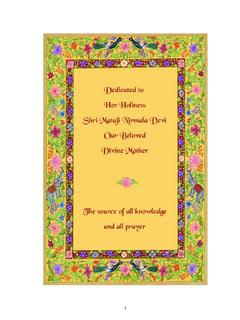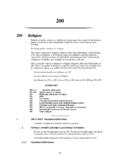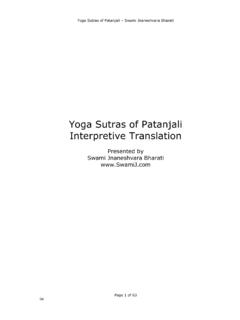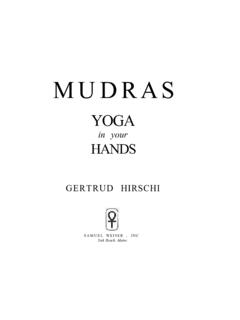Transcription of D n y n e s h w a r i - Amruta
1 D n y n e s h w a r i English translation of philosophical part of Dnyneshwari (1290 AD). Dnyaneshwari is a commentary on Gita, written 700 years ago by Saint Dnyneshwar (Jnanesvara or Gnanadeva) (1274-1297). It brings Vedanta and other spiritual philosophies to common man. It explains the various paths a person can take for spiritual progress and ultimate liberation. Apart from mythical stories, not much is known about the life of Dnyaneshwar and his brothers. Judging purely by their writings, they lead a hard life. In 1296 AD, Dnyaneshwara, aged 25, walked into a stone-walled room in Alandi near Pune. He had it closed and passed away in samadhi (a state of spiritual liberation). The room has not been opened since then and Alandi has been a revered place. None of his siblings were to enjoy a long worldly life either and passed away within months of Dnyaneshwar's samadhi. Dnyaneshwari is a commentary on the Gita written more than seven centuries ago by Saint Dnyaneshwar in the contemporary Marathi language in verse form using the ovi style.
2 It brought the philosophy of the Gita, until then the prerogative of Sanskrit pundits, to common man. It is written in verse form as used to be custom of those days, An excellent spiritual seekers guide, it discusses in detail four different paths viz. The path of Knowledge, the path of action, the path of yoga and the path of devotion to choose from depending upon the psychological make up of the seeker. It presents the cream of Vedanta philosophy, Sankhya philosophy, kundalini yoga and the practice of devotion. While Gita is difficult to understand to a common man, Saint Dnyaneshwar has written Dnyaneshwari (Original name Bhavarthadeepika) specifically for common man and therefore the text is easy to understand. Saint Dnyaneshwar wrote this critique at the age of sixteen on the instructions of his Guru and elder (only by two years) brother Nivruttinath. Nivruttinath was a disciple of Gahininath, one of the nine gems or Navnaths of the Nath sect. Dnyaneshwari written seven hundred years ago is still vibrantly alive and is regularly read in many homes in Maharashtra.
3 Due to changes in the Marathi language over the last few centuries the text is not easily understandable, but many prose translations are available. While writing commentary on Gita Dnyaneshwar Maharaj has used a lot of examples and similes from day to day life and from nature to make the meaning very clear to a common reader. However, with today's educational levels many of these are not necessary and often they distract the reader from the smooth flow of the philosophical thought. In this translation therefore (1) Only the philosophical part of the text has been retained except where there is need for clarifying the meaning. (2) Rather than presenting the translation sequentially it is presented as a group of sequential verses (omitting of course those having similes etc.) with a cogent meaning and are subtitled. Omitting unnecessary similes (for modern reader) and further omitting the traditional obeisances made to various deities and his Guru, only 5752 ovis (verses) have been used out of the total 9032 ovis, reducing the material by about a third.
4 This translation, thus truncated, is intended more for an intellectual reader rather than the pious. It is the intellectuals who hold executive and professional positions in today's socio-economic world and are the ones who can influence the society positively or negatively. But their world is a world of perpetual haste and cannot afford long winded texts of the old days. Thus a shortened version of Dnyaneshwari is most suited for this class un order to turn their influence on the positive side. Being a commentary on the Gita, Dnyaneshwari also has 18 chapters. PROLOGUE This translation of Dnyaneshwari contains only the philosophical part of the text. When Dnyaneshwar Maharaj wrote Bhavarthadeepika, now known as Dnyaneshwari, seven hundred years ago for the common man, general educational levels were not as comprehensive as today, there was no printing press and books had to be transcribed by hand. Dnyaneshwar Maharaj used many similes and examples from human society as well as nature to explain the points made in the Gita.
5 Dnyaneshwar Maharaj belonged to Nath Sect where Guru is worshipped more than any deity and Dnyaneshwari contains a lot of text dedicated to the praise of and obeisances to his Guru Nivruttinath (who was also his elder brother, elder by only two years), besides obeisances to several other deities as is traditional in Hindu religious literature. These similes and examples are no longer necessary for today's rader who is better read and informed and in fact it is the experience that too many of these distract the reader from the main flow of thought. In this translation, these parts are omitted except where necessary. The text involving obeisances also has been omitted as it is also extraneous to the philosophical part. The intention in adopting this approach is to make an edited translation available to an intellectual reader. The pious readers can always use the half a dozen verse by verse translations available in bookshops. Due to differences in the structure of Marathi and English, verse by verse translations pose difficulty in collating the verses to make a single long sentence.
6 In this translations, a set of consecutive verses have been grouped together to make sentences and paragraphs with cogent meaning and the paragraphs are given sub-headings for easy reference and meaning. Thus this translation can claim to assist a rader in faster reading. By this approach the text was shortened to 5752 verses out of the total of 9032 verse (ovis). INTELLECTUAL APPEAL This translation, thus truncated, is intended more for an intellectual reader rather than the pious. It is the intellectuals who hold executive and professional positions in today's socio-economic world and are the ones who can influence the society positively or negatively. But their world is a world of perpetual haste and cannot afford long winded texts of the old days. Thus a shortened version of Dnyaneshwari is most suited for this class un order to turn their influence on the positive side. There is a subconscious respect for God in the hearts and minds of everybody and a professional or an executive is no exception.
7 It only needs to find a way out. Intelligence and spirituality seem to be well associated mutually. Greatest spiritual persons were people of high intelligence who were curious enough to ask themselves the question "Who am I?" and in looking for the answer, took to spiritual path; or they were persons who had a natural attraction towards the spiritual path. While some renounced the world and became sanyasis, contrary to the belief many have even today, one need not forsake his family life in order to take up a spiritual path. The reader will find it stated in the Dnyaneshwari that it is not necessary to give up your normal life in order to search for God. You have a choice of paths which ultimately end, according to the Indian philosophy and the experience of the spiritual masters, into Self-realisation a realisation that you are no different from the Almighty. That is why every intelligent person should read Dnyaneshwari. There are many reasons why intelligent persons should turn to the spiritual path.
8 Intelligence like other qualities is a gift of God. It is not a personal achievement and therefore, instead of being proud about one's intelligence the correct attitude should be that of gratitude towards the Almighty for possessing it. Having this gift of God, one may expect an intelligent executive or professional to utilise that gift to experience Self-realisation. Many persons seem to realise this and become spiritual seekers. A large number of people joining the various spiritual institutions like the Ramakrishna Ashram, the order of Samarth Ramdas at Sajjangad in Maharashtra and many others are persons of high academic achievement. For many intellectuals however there are many initial problems and mental hurdles to be overcome before he becomes a seeker. The first hurdle is the misconception that one has to renounce the world and be a Sanyasi for taking up the spiritual path. The Gita (and naturally Dnyaneshwari) teaches us otherwise and considers Sanyas as unnecessary.
9 The second hurdle is the fear that spiritual exercises would divert the mind from the duties of the office and impede success. This is also not correct. Spiritual exercises instill a discipline into one's person, remove fear and make one more efficient. In fact, many yoga and meditation techniques have been adapted for pacifying the mind and instilling a positive approach to life. Many executives pay high fees to attend such courses and workshops where these techniques are taught and find then beneficial. Even big commercial companies send their executives to such courses. The philosophy of the Gita goes much beyond that. The Third hurdle is the mental impediment about the availability of time. This again is baseless, for one can always find a few minutes in a day, even while travelling to work, to ponder over spiritual matters or read about it. The Fourth hurdle is the problem of how to go about it. Who would guide and tell whether the path taken is correct or not?
10 And so on. The Gita answers many of these questions and suggests many paths which one may choose from depending upon one's personality. Executives and professionals, by virtue of the nature of their work are constrained to practice a materialistic approach to life. They are therefore subject to all the stresses derived therefrom. The stresses and the resultant problems of health can be avoided and one can have a happy life if one understands and follows the basic philosophy of the Gita/Dnyaneshwari. The changes in attitude give happiness and lay a foundation for the current life as well as life after retirement. The changes are transmitted to one's family who also become happy. A few can pursue the spiritual path while leading a normal life and attain experience of God. Thus this translation which concentrates on the philosophy of Gita as interpreted by Saint Dnyaneshwar is eminently suitable for the intellectual class. THE GITA - SOME HISTORICAL INFORMATION The Gita is considered as a part of the Epic Mahabharata.





